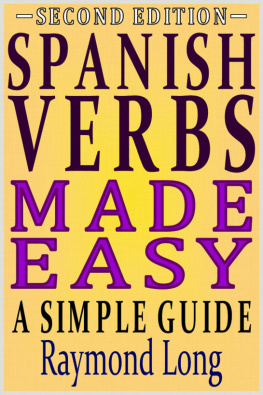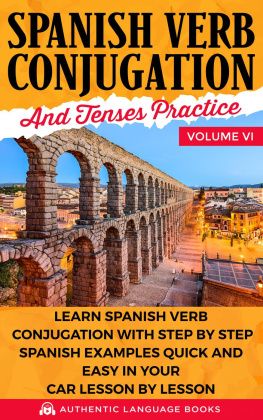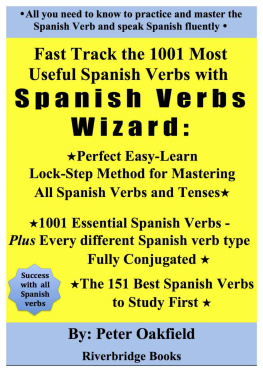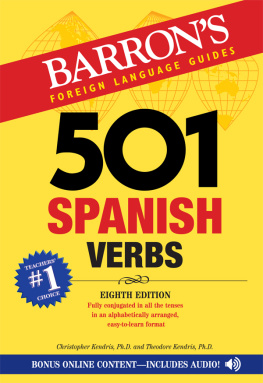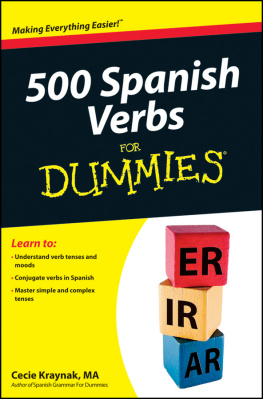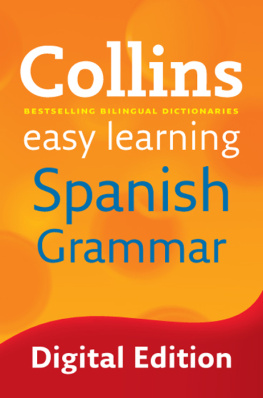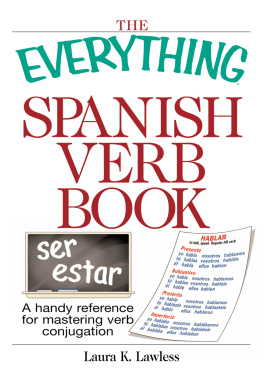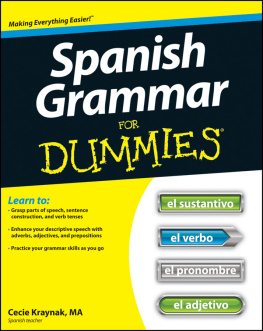Raymond Long - Spanish Verbs Made Easy: A Simple Guide
Here you can read online Raymond Long - Spanish Verbs Made Easy: A Simple Guide full text of the book (entire story) in english for free. Download pdf and epub, get meaning, cover and reviews about this ebook. year: 2010, publisher: Raymond Long, genre: Detective and thriller. Description of the work, (preface) as well as reviews are available. Best literature library LitArk.com created for fans of good reading and offers a wide selection of genres:
Romance novel
Science fiction
Adventure
Detective
Science
History
Home and family
Prose
Art
Politics
Computer
Non-fiction
Religion
Business
Children
Humor
Choose a favorite category and find really read worthwhile books. Enjoy immersion in the world of imagination, feel the emotions of the characters or learn something new for yourself, make an fascinating discovery.
- Book:Spanish Verbs Made Easy: A Simple Guide
- Author:
- Publisher:Raymond Long
- Genre:
- Year:2010
- Rating:5 / 5
- Favourites:Add to favourites
- Your mark:
- 100
- 1
- 2
- 3
- 4
- 5
Spanish Verbs Made Easy: A Simple Guide: summary, description and annotation
We offer to read an annotation, description, summary or preface (depends on what the author of the book "Spanish Verbs Made Easy: A Simple Guide" wrote himself). If you haven't found the necessary information about the book — write in the comments, we will try to find it.
For many people, the great stumbling block in learning Spanish is that big verb table. It looks a lot to remember. But there are patterns in there, meaning that you have to remember far less than it seems. This short book is not a complete language course, but a simple system focused on teaching you how to commit Spanish verb forms to memory.
Spanish Verbs Made Easy: A Simple Guide — read online for free the complete book (whole text) full work
Below is the text of the book, divided by pages. System saving the place of the last page read, allows you to conveniently read the book "Spanish Verbs Made Easy: A Simple Guide" online for free, without having to search again every time where you left off. Put a bookmark, and you can go to the page where you finished reading at any time.
Font size:
Interval:
Bookmark:
Spanish Verbs Made Easy : a Simple Guide RaymondLong Secondedition, p ublished byRaymond Long at Smashwords Copyright2012 Raymond Long Discover othertitles by Raymond Long at: www.raymondlong.co.uk This ebook islicensed for your personal enjoyment only. This ebook may not bere-sold or given away to other people. If you would like to sharethis book with another person, please purchase an additional copyfor each person. If youre reading this book and did not purchaseit, or it was not purchased for your use only, then please returnto Smashwords.com and purchase your own copy. Thank you forrespecting the hard work of this author. ==== INTRODUCTION TO THE FIRST EDITION (2010) Many people tryto learn Spanish, but are put off when they see the verb table.
Itseems huge. How can you learn all those forms? The truth is,those many forms belong in groups. Each such group tends to build astem in a consistent way. After that, a personal ending is added,and these endings are almost always the same across all thedifferent groups. Once you understand the internal logic behindthis, the forms are much easier to remember. Sections A to Eof this book make up a complete course in how to build the forms ofSpanish verbs.
Section F contains selected information on whatthese words mean and how to use them. ==== INTRODUCTION TO THE SECOND EDITION (2012) It seemssome readers expected more from the first edition of Spanish Verbs MadeEasy than it was evermeant to do. For this reason I feel the need to clarify itsintended purpose further. You can findtables setting out the forms of regular Spanish verbs indictionaries or on the web. You could consult these tables to findthe right verb form every time you needed to, but most learnerswant to memorise the verb forms, and this is what people finddifficult. The corepurpose of this book is to teach a memory system for remembering the forms (written and spoken) of Spanish regular verbs.
It's not toteach what the verbs mean or how they're used. To learn thosethings, consult a full Spanish language course. This book makessporadic mentions of meaning and usage where I think itappropriate, but don't expect full systematic coverage. Forinstance, this book was never intended to teach the range ofmeanings and usages for each tense of the verb. Nor doesthis book give consistent coverage to irregular verbs, or to thespelling changes that take place to write the same sound underdifferent circumstances, such as c and qu forthe k -sound( eg . in atacar , ataco , ataque ).
Thelatter are covered in my book The Rules of Spanish Spelling . ==== TABLE OF C ONTENTS ==== SECTION A In Section Awe'll see how a verb has a simple base-form. Many of the verb formsin Spanish can be created from this base-form by adding a singleending. --- LESSON A1: THEBASE-FORM OF THE VERB Spanishverbs are built up from a base-form , such as mira "look", canta "sing", asa "roast".This form is used to give an instruction or request to one person(the imperative singular ). It's also used to state that one person or thing( ie . ... Mira. "Helooks", "she looks" or "it looks." ... "Helooks", "she looks" or "it looks." ...
Pedro mira. "Pedro looks." ... Mira! "Look!"(instruction or request to only one person) ... Canta. "Hesings", "she sings" or "it sings." ... "Elvira sings." ... "Elvira sings." ...
Canta! "Sing!"(instruction or request to only one person) Thebase-forms above are each made up of a root , mir- or cant- or as- , followed by a base-vowel . The most common group of verbs is the a -verbs, which have a as their base-vowel: ...Root mir +base-vowel a >base-form mira "look" ...Root cant +base-vowel a >base-form canta "sing" ...Root as +base-vowel a >base-form asa "roast" Thesecond most common group of verbs is the e -verbs, which have e astheir base-vowel: ...Root beb +base-vowel e >base-form bebe "drink" ...Root com +base-vowel e >base-form come "eat" ... Bebe. "Hedrinks", "she drinks" or "it drinks." ... Rosa bebe. "Rosadrinks." ...
Bebe! "Drink!"(instruction or request to only one person) Pronunciation :The letter e is neversilent in Spanish. Even final e ispronounced. The words bebe and come are bothtwo syllables, pronounced something like BEH-veh and KO-meh . --- LESSON A2: THEIMPERATIVE An imperative is an instruction or a request.It can be singular (to oneperson) or plural (to morethan one). Theimperative singular uses the base-form. The imperative pluraladds -d .
A -verbs : ...Imperative singular: Mira! "Look!"(to one person) ...Imperative plural: Mirad! "Look!"(to more than one) E -verbs : ...Imperative singular: Come! "Eat!"(to one person) ...Imperative plural: Comed! "Eat!"(to more than one) Pronunciation :Adding -d shifts thestress to the last syllable, so the plural forms mirad and comed are pronounced something like mee-RAD and ko-MED . --- LESSON A3: THEINFINITIVE Theinfinitive means "to do". It is formed by adding -r to the base-form. ... cantar "tosing" ... comer "toeat" ... beber "todrink" Pronunciation :Adding -r shifts thestress to the last syllable, so the infinitives asar and comer arepronounced something like a-SAR and ko-MAIR . beber "todrink" Pronunciation :Adding -r shifts thestress to the last syllable, so the infinitives asar and comer arepronounced something like a-SAR and ko-MAIR .
Writing system :The forms cantad and cantar are bothstressed on the final syllable. But no acute accent is written onthe vowel-letter, because it's usual for Spanish words ending in aconsonant other than s or n to have final-syllable stress (seeAppendix 1). For this reason we don't write cantd or cantr . --- SECTION ASUMMARY A regularverb has a base-form madeup of a root plusa base-vowel . Thisbase-form is a basic building block from which many verb forms arebuilt. The base-form itself functions as the third person singularpresent (meaning"he/she/it does") and as the imperative singular (instruction or request to one person).
The imperative plural (instruction or request to more than one person)adds -d to the end ofthe base-form. The infinitive (meaning "to do") adds -r tothe end of the base-form. ==== SECTION B InSection A we saw how words are built by adding a single ending tothe base-form. In Section B we'll meet the personal endings , which indicate who does the action. Likethe endings in Section A, these are added to the end of thebase-form. --- LESSON B1:PERSON AND NUMBER Spanishhas three persons : firstperson (I, we), second person (you), and third person (he, she, it,they). --- LESSON B1:PERSON AND NUMBER Spanishhas three persons : firstperson (I, we), second person (you), and third person (he, she, it,they).
Each of these can be singular number (one person) or plural number (more than one). This gives six combinations. Fromnow on these will be called 1S, 2S, 3S, 1P, 2P, 3P. ... Firstperson singular (1S): I ... Secondperson singular (2S): you (one person) ...
Thirdperson singular (3S): he, she, it ... Firstperson plural (1P): we ... Secondperson plural (2P): you (more than one) ... Thirdperson plural (3P): they Spanishhas a single set of personal endings to represent these six combinations of person with number,which are used to built most verb forms. These endingsare: ... 3S: noending ...1P: -mos ...2P: -is ...3P: -n --- LESSON B2: THEPRESENT Basic rule : Toform the present : 1. 3S: noending ...1P: -mos ...2P: -is ...3P: -n --- LESSON B2: THEPRESENT Basic rule : Toform the present : 1.
Take thebase-form 2. Add theappropriate personal ending Exception : The1S changes the base-vowel from a to o . A -verbs : ...1S: miro "I look"(base-form mir-a > mir-o + noending) ...2S: miras "you(singular) look" (base-form mir-a + -s ) ...3S: mira "he/she/itlooks" (base-form mir-a + noending) ...1P: miramos "welook" (base-form mir-a + -mos ) ...2P: miris "you(plural) look" (base-form mir-a + -is ) ...3P: miran "theylook" (base-form mir-a + -n ) E -verbs : ...1S: bebo "I drink"(base-form beb-e > beb-o + noending) ...2S: bebes "you(singular) drink" (base-form beb-e + -s ) ...3S: bebe "he/she/itdrinks" (base-form beb-e + noending) ...1P: bebemos "wedrink" (base-form beb-e + -mos ) ...2P: bebis "you(plural) drink" (base-form beb-e + -is ) ...3P: beben "theydrink" (base-form beb-e + -n ) Pronunciation :Generally in these forms, the stress is on the last syllable butone. In miro , miras , mira , miran , this isthe syllable before the base-vowel, eg . miran soundslike MEE-ran . The 1Ppersonal ending - mos adds anextra syllable, so on the principle that the last syllable but oneis stressed, this shifts the stress to the base-vowel: miramos sounds like mee-RA-mos .
Next pageFont size:
Interval:
Bookmark:
Similar books «Spanish Verbs Made Easy: A Simple Guide»
Look at similar books to Spanish Verbs Made Easy: A Simple Guide. We have selected literature similar in name and meaning in the hope of providing readers with more options to find new, interesting, not yet read works.
Discussion, reviews of the book Spanish Verbs Made Easy: A Simple Guide and just readers' own opinions. Leave your comments, write what you think about the work, its meaning or the main characters. Specify what exactly you liked and what you didn't like, and why you think so.

